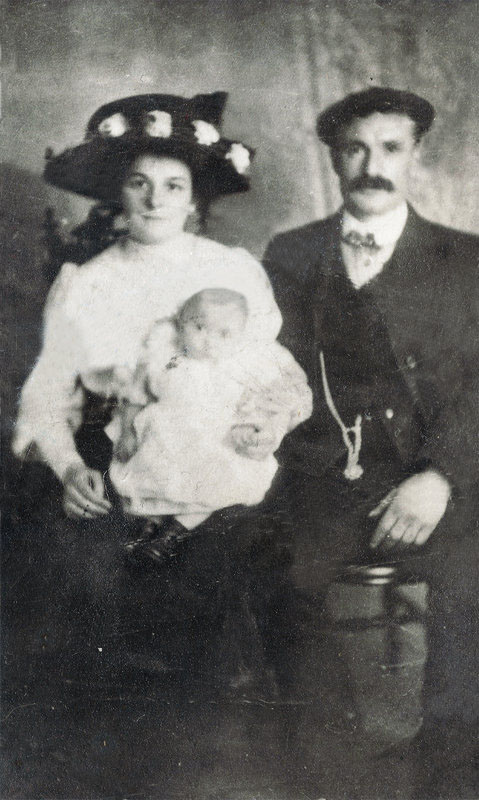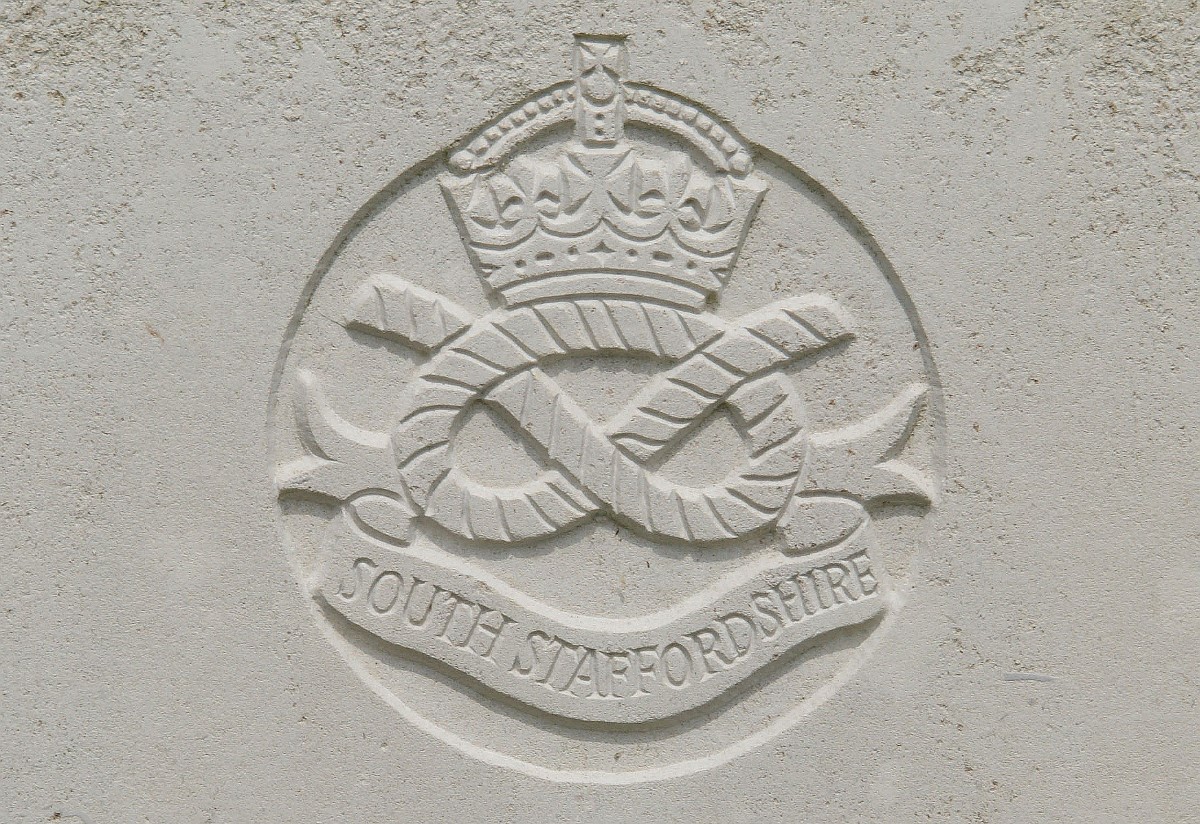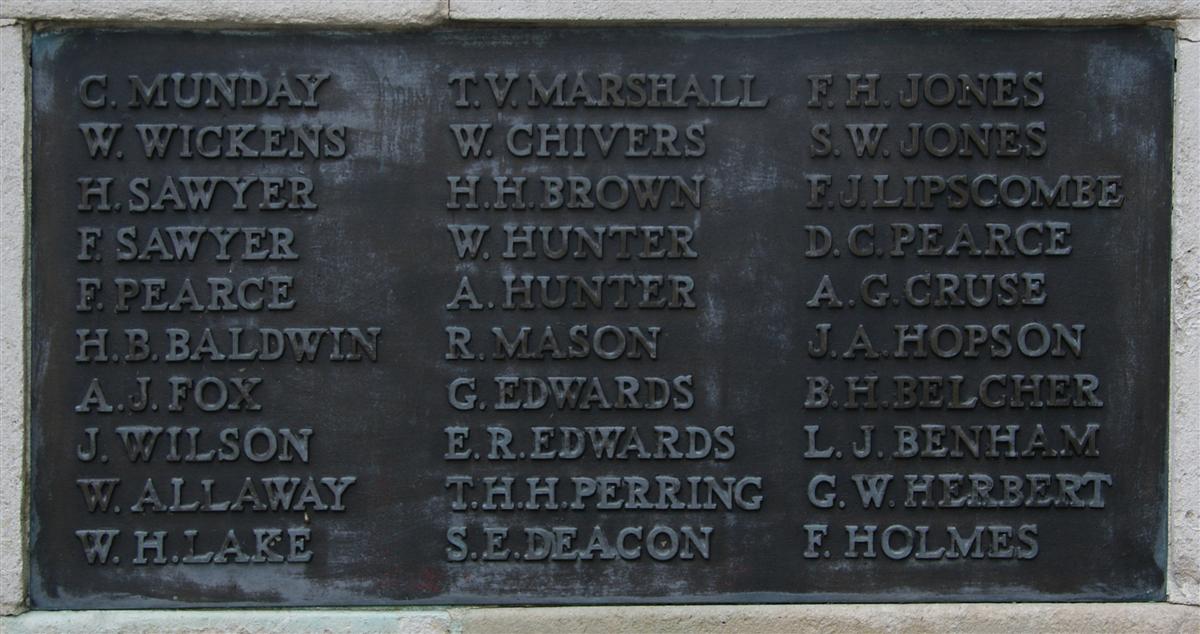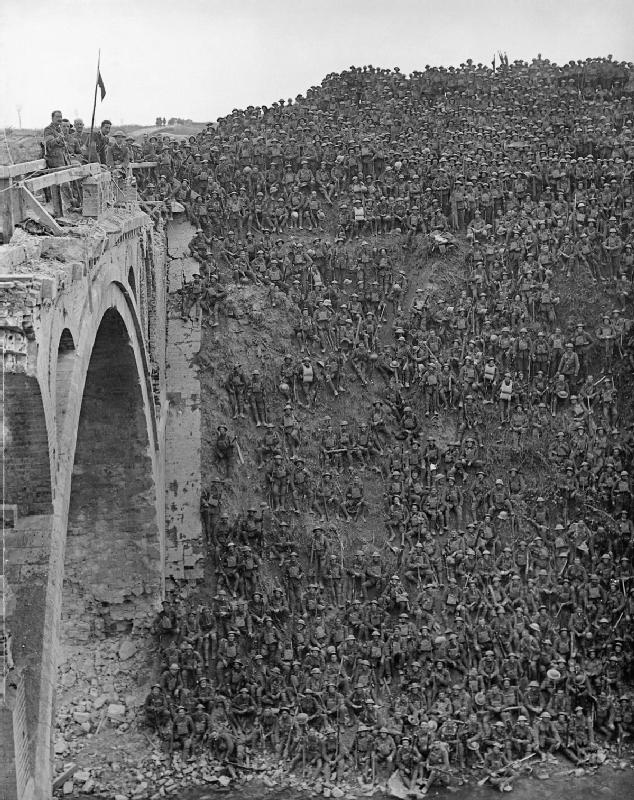William John Allaway
Lance Corporal 29897 William John Allaway, 1st/6th Battalion, South Staffordshire Regiment
 William Allaway with his wife Rachel and eldest child, Violet. (courtesy Daniel Norris) |
He was one of a large family, his father having had at least fifteen children with two wives. William was the fifth of seven known children of his father’s first marriage to Agnes Ann Harriet Wilson. Agnes died in 1887 shortly before the birth of her last child was registered. The seven children were Agnes Evelyn Gertrude (born 1876), Minnie Wilson (1878), Beatrice Alice (1880), Robert Charles (1882-1883), John William (1884), Albert Edward (1886) and James (1887).
Agnes’s death at the young age of 37 was very likely to have been caused by complications during or after James’ birth. It was the sad lot of too many children in that time to be the cause of their mother’s decease.
On 22 July 1889 Robert remarried, to Mary Kate Butler, in the church of St John the Baptist, Hillingdon. By the census of 1891 the Allaway’s were living in Chapel Road, Hillingdon, next door to Mary’s parents James and Sarah Butler.
It was not long before the family began to grow with the birth of a daughter, Martha Kate on 23 January 1890. Martha was followed by Malcombe Jack (1891), Joseph Alfred (1 January 1893), the twins Edmund/Edwin and Stephenson (1894), Sarah Lydia (19 December 1895), Richard Jim (29 May 1898) and Annie Matilda (3 September 1901). However there were also deaths, the twins lived for only 3 months (Stephenson) and 5 months (Edmund), Richard also died after 3 months, Sarah lasted a little longer but died aged 19 months in 1897.
Thus it was that Mary Kate would fill in her 1911 census return with the information that she had had eight children, but only four were then living. Sadly the census also reveals that she was a widow, Robert having died in 1907.
In 1910 William married Rachel Joanna Swatton in Newbury. Rachel was a Newbury lass; it seems likely that she left Newbury for a job in the Hillingdon area, where she met William. Many girls from Newbury found work in domestic service in the London area. They lived for a while in the West Drayton where their first child, Violet Agnes was born. Their second child, William, was born in Newbury in 1912 – at the time of the 1911 census Rachel and Violet were staying with her parents in Newbury without William, perhaps he had some itinerant employment (his census entry has not been found). The family then settled in West Bromwich where their three remaining children were born: Francis W (1914), Albert Edward (1916) and Gladys (1918).

The badge of the South Staffordshire Regiment, as used on a CWGC headstone. |
By October 1918 he was definitely serving in the 1/6th Battalion, which was a Territorial battalion. By 1918 the previously clear distinctions between the Regular and Territorial battalions had been blurred so much that this meant little.
By October 1918 the traditional view of the Great War, of two lines of entrenched fortification stretching from the Swiss border to the North Sea, where huge offensive efforts resulted in territorial gains measured in yards, was no longer applicable. Since August the Britsh, American and French forces were in the ascendant. First pushing the Germans out of the territory they gained in their massive spring offensive; then bursting through the much vaunted Hindenberg Line, pushing the enemy back towards the German border. Every day the British Army was attacking somewhere along the front, if the Germans managed to hold in one place the offensive would shift to another location. The German armies were on the point of collapse, but still fought on bravely and inflicted heavy losses on the relentless Allied forces.
The 1/6th South Staffordshire Battalion was a part of the 137th (Staffordshire) Brigade in the 46th (North Midland) Division. On 2 October 1918 Brigadier General J C Campbell VC CMG DSO, commanding officer of 137th Brigade, addressed his men from the bridge over the St Quentin Canal at Riqueval. The brigade had just taken part in a successful fight (the Battle of Bellenglise) to break through the Hindenburg Line at a particularly strong point, which included crossing the canal, and establishing a bridgehead on the opposite bank. Although aided by the weather (a thick fog) this was 46th Division’s finest hour, and Campbell wanted his men to know how proud he was of their achievement. The occasion was captured by a photographer and has become one of the most iconic images of the war.
The following day it was back to work as the division pushed forward in what has been designated the Battle of Ramicourt. The divisional history1 states: The Battles of Bellenglise and Ramicourt may be contrasted in a single sentence: Bellenglise was a miracle, Ramicourt was a victory.
At Ramicourt the problem was to break out of the bridgehead and through the rearmost element of infamous Hindenburg Line a partially completed, but strongly wired system of trenches. The trenches themselves were little more than a scrape in the ground with hastily dug rifle pits to protect the infantry, but, every 50 yards or so there was a strong concrete bunker capable of protecting teams of machine gunners from almost everything the British artillery could throw at them. The other major problem was time – the division had only 14 hours to plan the attack and move everything into place for zero hour – and 12 of those hours were during the dark of a moonless night.
Amazingly all but one artillery battery opened fire on time to protect the advance of the infantry with a creeping barrage designed to keep the German machine gunners in their bunkers until it was too late for them to offer an effective defence.
At zero hour (6.05am) 137th Brigade attacked with 139th (Sherwood Foresters) Brigade to its left and units of 32nd Division to the right. The main obstacles were the villages of Ramicourt and Montbrehain, the main problem was Mannequin Hill from the top of which German observers had a good view of the battlefield and could direct artillery and machine gun fire on to the advancing British.
War Diary 1/6th Battalion, South Staffordshire Regiment - 3 October 1918.
The Battalion moved off from BELLEENGLISE at 02.00 (3rd inst)
The Battalion was in position by 05.00. Zero hour was 06.05. The Battalion was on the right of the attack, the 32nd Division taking SEQUEHART on our right flank. “C” and ‘D’ Companies were in the first wave, ‘A’ and ‘B’ Companies in the second wave.
The battalion met with very strong opposition from the enemy, his machine gunners being especially troublesome. After some very hard fighting during which many of the enemy were killed and many captured, the Battalion reached its objective by about 08.00.
Outposts were pushed forward to MANNEQUIN HILL but later had to be withdrawn owing to the intense enfilade machine gun fire. Unsuccessful counter-attacks on both flanks were made by the enemy. Shelling and machine gun fire was severe throughout the day. 2/Lt C P H Sylvester and 2/Lt G Evans were killed and 2/Lt S Walters severely wounded. Capt P H Teeton and Capt N Dickson were also wounded.
Not a story of complete success but enough to see the British through the last vestiges of the Hindenburg Line at this point.
The diary does not report the non-officer casualties but William was reported missing after this action. His body was discovered soon after and was buried in Ramicourt British Cemetery (grave B.11). The village of Ramicourt was captured by the 1/5th, 1/6th and 1/8th Sherwood Foresters (139th Brigade) on the day William died and the cemetery was started soon after.
 William's name on Newbury War Memorial (lower left) |
The Commonwealth War Graves Commission records the death of 18 men from the 1/6th South Staffordshire Battalion that day; many more would have been wounded, some would, in time, have died from their wounds.
Following his death Rachel returned to her family in Newbury, where their children grew up and, in most cases, married and raised their own families.
In 1921 Rachel married Douglas Fish with whom she had four more children (Douglas, 1922; Leslie, 1923; Stanley, 1926; and Cyril, 1929).
Locally William he is remembered on Tablet 3 of the Newbury Town War Memorial.
1. Breaking the Hindenburg Line: The Story of the 46th (North Midland) Division, Maj R E Priestley MC RE, Fisher Unwin Ltd. 1919


